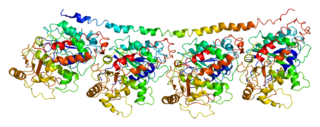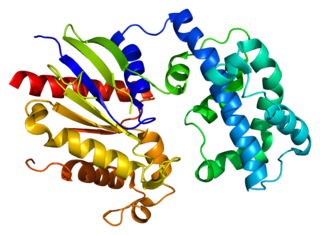Dynactin subunit 4 is a protein that in humans is encoded by the DCTN4 gene. [5]
Dynactin subunit 4 is a protein that in humans is encoded by the DCTN4 gene. [5]

Signal transducer and activator of transcription 2 is a protein that in humans is encoded by the STAT2 gene. It is a member of the STAT protein family.

Dynactin subunit 1 is a protein that in humans is encoded by the DCTN1 gene.

Tubulin alpha-4A chain is a protein that in humans is encoded by the TUBA4A gene.

Proteasome inhibitor PI31 subunit is a protein that in humans is encoded by the PSMF1 gene.

Upstream stimulatory factor 2 is a protein that in humans is encoded by the USF2 gene.

Dynactin subunit 2 is a protein that in humans is encoded by the DCTN2 gene

Alpha-centractin (yeast) or ARP1 is a protein that in humans is encoded by the ACTR1A gene.

60S ribosomal protein L7 is a protein that in humans is encoded by the RPL7 gene.

Origin recognition complex subunit 5 is a protein that in humans is encoded by the ORC5 (ORC5L) gene.

Origin recognition complex subunit 3 is a protein that in humans is encoded by the ORC3 (ORC3L) gene.

V-type proton ATPase subunit e 1 is an enzyme that in humans is encoded by the ATP6V0E1 gene.

Acid-sensing ion channel 2 (ASIC2) also known as amiloride-sensitive cation channel 1, neuronal (ACCN1) or brain sodium channel 1 (BNaC1) is a protein that in humans is encoded by the ASIC2 gene. The ASIC2 gene is one of the five paralogous genes that encode proteins that form trimeric acid-sensing ion channels (ASICs) in mammals. The cDNA of this gene was first cloned in 1996. The ASIC genes have splicing variants that encode different proteins that are called isoforms.

Synaptotagmin-9 is a protein that in humans is encoded by the SYT9 gene.

Mediator of RNA polymerase II transcription subunit 25 is an enzyme that in humans is encoded by the MED25 gene.

Dynactin subunit 3 is a protein that in humans is encoded by the DCTN3 gene.

Synaptotagmin-7 is a protein that in humans is encoded by the SYT7 gene.

Zinc transporter ZIP3 is a protein that in humans is encoded by the SLC39A3 gene.

Guanine nucleotide-binding protein subunit alpha-13 is a protein that in humans is encoded by the GNA13 gene.

Serine/threonine-protein phosphatase 4 regulatory subunit 1 is an enzyme that in humans is encoded by the PPP4R1 gene.

Acid-sensing ion channel 4 (ASIC4) also known as amiloride-sensitive cation channel 4 (ACCN4) is a protein that in humans is encoded by the ASIC4 gene. The ASIC4 gene is one of the five paralogous genes that encode proteins that form trimeric acid-sensing ion channels (ASICs) in mammals. The cDNA of this gene was first cloned in 2000. The ASIC genes have splicing variants that encode different proteins that are called isoforms.
| This article on a gene on human chromosome 5 is a stub. You can help Wikipedia by expanding it. |